As a beginner bass angler, I hit the water armed only with the knowledge of overhand knots, which can be quite frustrating because they wouldn’t cinch down and secure the hook to the line.
When I discovered different fishing situations require different knots, I began to catch more fish.
There’s a considerable difference between the knots needed to join two line sections and those used to tie a fishing line to a hook.
No matter if you’re chasing smallmouth or largemouth bass, knowing the right fishing knots is critically important.
Take the time to learn some of the best bass fishing knots highlighted below before going for your next fishing trip.
Anglers.com Community Coordinator Wesley Littlefield shows us how to tie 4 essential bass fishing knots in this YouTube video.
The Best Bass Fishing Knots
You don’t have to be a scout to possess the right knot-tying skills or become an expert in these fishing tips.
This article contains our top picks for bass fishing knots that are relatively easy to learn. These seven knots don’t sacrifice durability, usability, or strength.
Palomar Knot
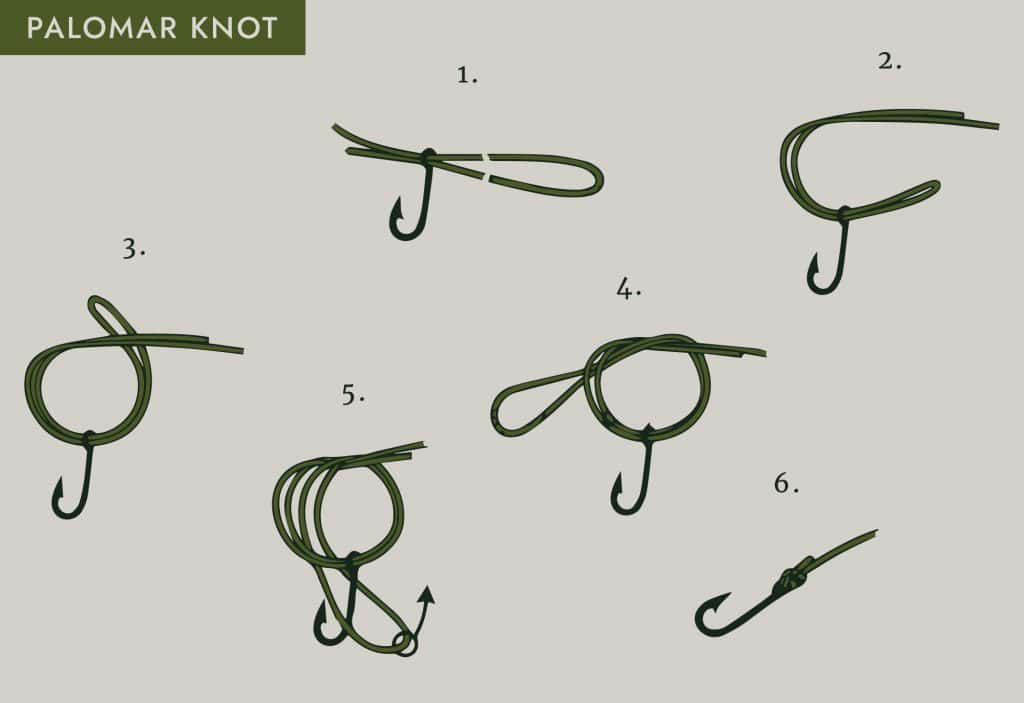
The Palomar knot is among the best knots for fishing lures and a great choice if you’re looking for a knot with a braided fishing line.
It’s a great knot for every beginner to learn despite initially looking slightly tricky. All you need is to master it through regular practice.
The advantages of the Palomar Knot include the following.
- It’s close to being a perfect knot
- It’s a simple knot, and it takes a short time to master
Follow these steps to tie a Palomar Knot.
- Double your line
- Push the loop through the hook’s eye
- Tie a loose overhand knot
- Tighten the fishing line
- If necessary, trim the line’s loose end.
Improved Clinch Knots
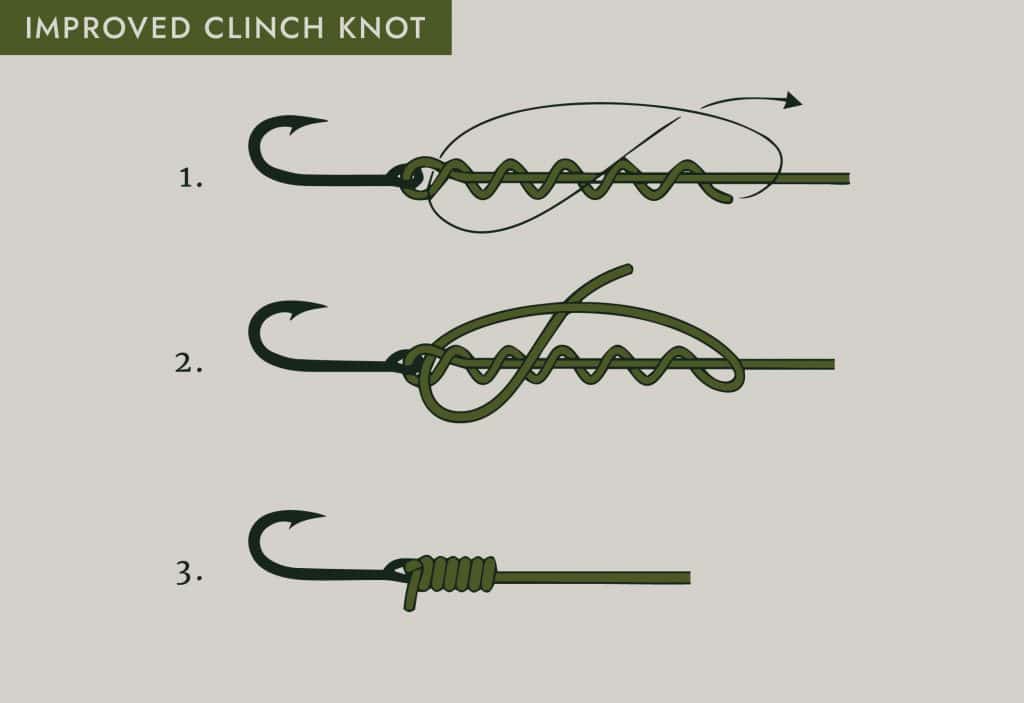
(Photo credit: NetKnots)
The improved clinch knot is also known as the Salmon knot and is also one of the best bass fishing knots.
It’s among the most widely used knots and provides anglers with an ideal method to secure a fishing string to a swivel, lipless crankbait, or hook. This knot is commonly used to fasten a fly to the leader.
The improved clinch knot has a myriad of advantages which include the following.
- Its extra final tuck increases your chances of holding a big fish
- It’s well suited for attaching a small diameter tippet to a heavy wire hook
- It’s regarded as a fisherman’s reliable standby
If you’re using a mono 30lb test line or larger, you should avoid improved clinched knots since they’re harder to tie with heavier lines.
Follow the below steps to tie improved clinch knots.
- Thread the string through the hook’s or swivel eye.
- Pull around 6 inches of the line through and double it against itself.
- Make five to seven raps around the vertical line with the loose end.
- Pass the line’s end through the just-created big loop while ensuring the coils don’t overlap.
- Moisten and pull both ends of the line till tight.
- If necessary, trim the loose ends of the line.
Loop Knot

(Photo credit: NetKnots)
Mastering the loop knot enables you to give your lure or fly more action to entice fish. The loop knot for crappie jigs doesn’t grip the eye, allowing it to remain flexible.
As a result, the lure maintains a natural movement in the water.
The advantages of the loop knot include the following.
- It leaves a weed-less tag end
- It’s a strong knot
- It’s very fast and easy to knot
Follow the steps below for loop knot tying.
- Make an overhand knot in the fishing line about 10 inches from its end.
- Pass the tail end through the hook eye and back through the overhand knot loop.
- Wrap the tail end four to five times on the standing part and bring it back through the overhand knot.
- Moisten the knot to strengthen it, then pull the tail end slowly to snap the wraps loosely together.
The Uni Knot
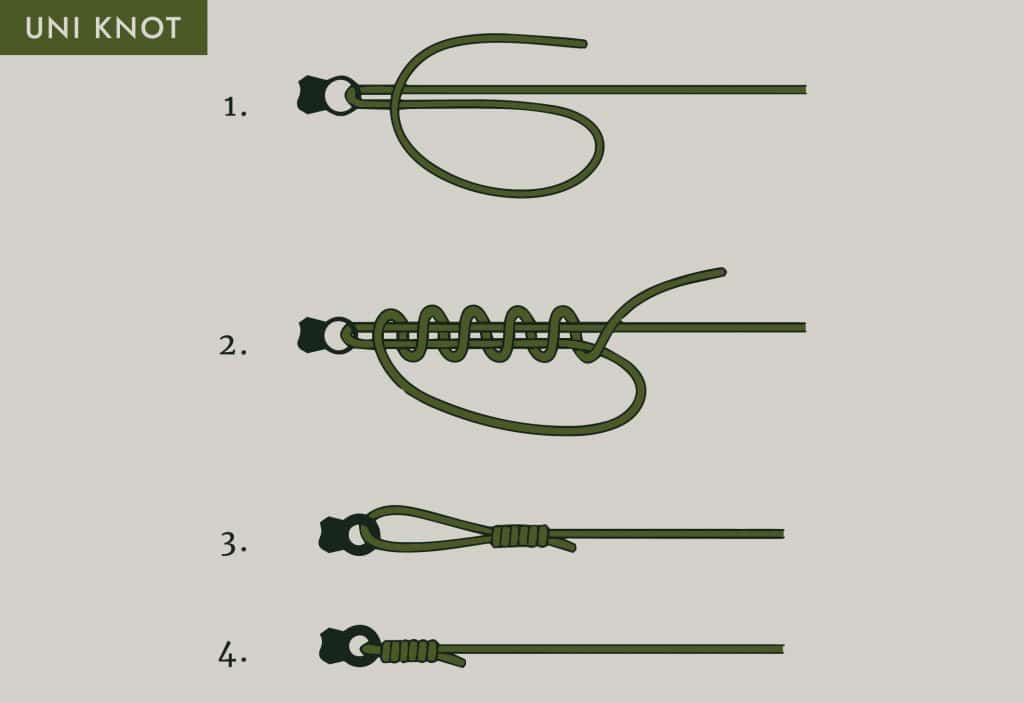
(Photo credit: NetKnots)
The unit knot, also known as the Duncan knot, is one of the versatile fishing knots for bass with several applications. It’s alternatively called a Double Uni Knot or Double Grinner when used to join two lines.
This knot transforms as it’s fastened. The inner wraps become external and vice versa. A Uni-Knot is tied around another line to join two lines.
The advantages of Uni knot include the following.
- Great knot strength when tied around a large diameter eye
- Retains a high proportion of line strength
- Reasonably simple to tie even in the dark
- Works well with both monofilament and braided main lines
Follow these steps to tie the Uni Knot.
- Run about 6 to 8 inches of line through the lure split ring or hook eye.
- Fold the tail end back so that it’s parallel to the main line.
- Place the tail end over the doubled string to form a loop against it.
- Wrap four to six times inside the already-formed loop.
- Lubricate and pull tight.
San Diego Jam Knot
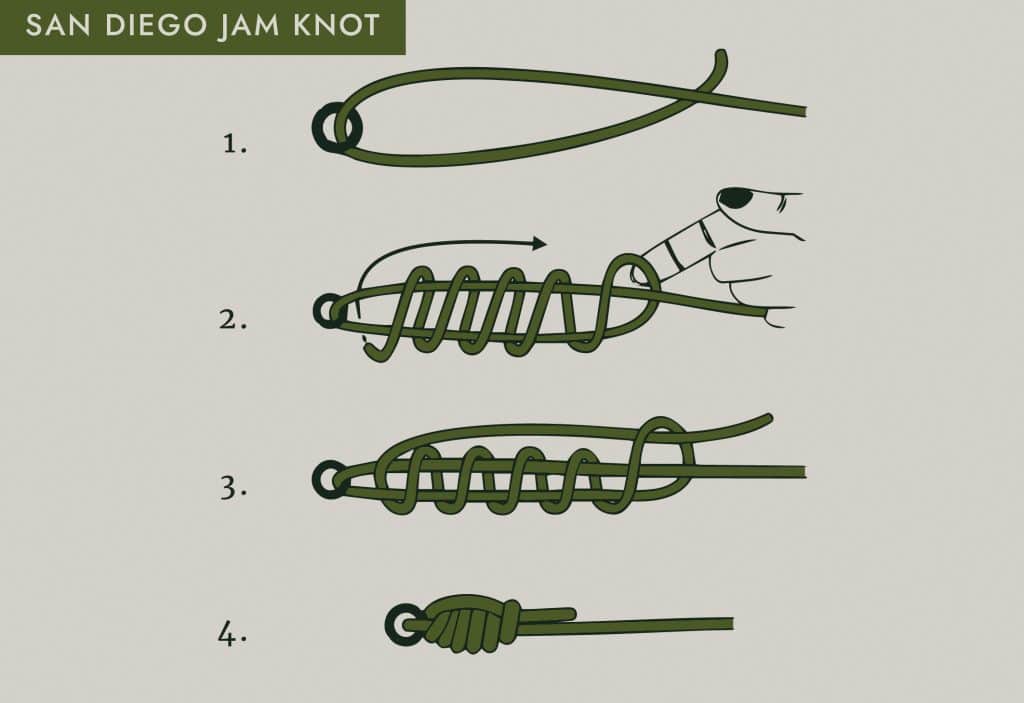
(Photo credit: NetKnots)
People who’ve tested the San Diego Jam Knot argue that it retains the line’s strength much more than other fishing knots.
San Diego Jam Knot, also known as the Heiliger Knot or the Reverse Clinch Knot, was popularized particularly with tuna fishermen.
It’s among the best knots for crankbaits and suitable for braided line, monofilament line, and fluorocarbon leaders.
Its significant benefit is that it’s relatively easy to learn and tie.
Follow the below steps to tie the San Diego Jam Knot.
- Pass the line end through the lure or hook eye, allowing a heavy lure to hang down.
- Loop the end of the tag over your index finger and make five to seven wraps around the double line.
- Feed the tail end between the double lines, then run through the loop before removing your finger.
- Moisten the line and pull the tail end tight.
- Ensure the turns form a neat spiral as you tighten the knot.
Albright Knot

(Photo credit: NetKnots)
Anglers use this bass fishing knot to join two pieces of lines of unequal thickness, such as a light main line to a heavy leader.
This knot is relatively smooth, passes through guides quickly, and is among the best knots for a jig head. You can coat the Albright Knot with rubber-based cement to make it more secure and smoother.
The advantages of the Albright knot include the following.
- Known to be the strongest knot for joining lines
- Used to tie on a mono or fluoro leader to a braided line
- Highly versatile and very secure
- Simple to assemble and easy to learn
Follow the below steps to tie an Albright Knot.
- Lay two line pieces out, ensuring they face opposite directions.
- Cross the line pieces and double the left side back.
- Pull the right piece down, ensuring the loop hangs above.
- To make a loop, pull the line end up, then over.
- Make eight to ten loops of the tie around the left piece, ensuring they’re neat and tight.
- Tighten the line by pulling on both of its ends.
Arbor Knot

(Photo credit: NetKnots)
The Arbor Knot, alternatively known as the Canadian Jam Knot, is primarily used to attach a fishing line to a fishing reel.
The advantages of the Arbor Knot include the following.
- It’s highly effective
- It’s easy to learn and simple to tie
Follow the steps below to tie an Arbor Knot.
- Encircle the reel arbor with the line
- Make an overhand knot around the running line’s tag end
- Secure the tag end with an overhand knot
- Fasten the tail end overhand knot, ensuring it packs snugly against the overhand knot around the fish running line.
How To Choose the Right Knot
Whether you’re a newbie angler or a seasoned angler with vast experience fishing the Texas rig, your bass fishing line is the most critical link between you and the bass.
To choose the best knot for bass fishing, consider the following.
Be Knowledgeable About Different Fishing Knots
Fishing requires more than just a reel and a great rod. Knowing the various types of knots will enable you to choose the most appropriate one for your angling needs.
You’ll also get to know their strength and reliability. Although there are over 70 fishing knots, we’ve found that the above seven are the best knots for bass fishing and rigging a crankbait.
A few others are the blood knot, snell knot, Trilene knot, and FG knot.
Know the Strongest Knot for Bass Fishing
A few bass fishing knots stand out from the crowd. Many anglers point to the Palomar Knot as the strongest when tying a swivel or hook to a line.
Compared to other fishing knots for bass, the Palomar Knot retains the highest percentage of line strength. This knot is also relatively simple to make, even in the dark.
Know the Best Fishing Knots for Lures
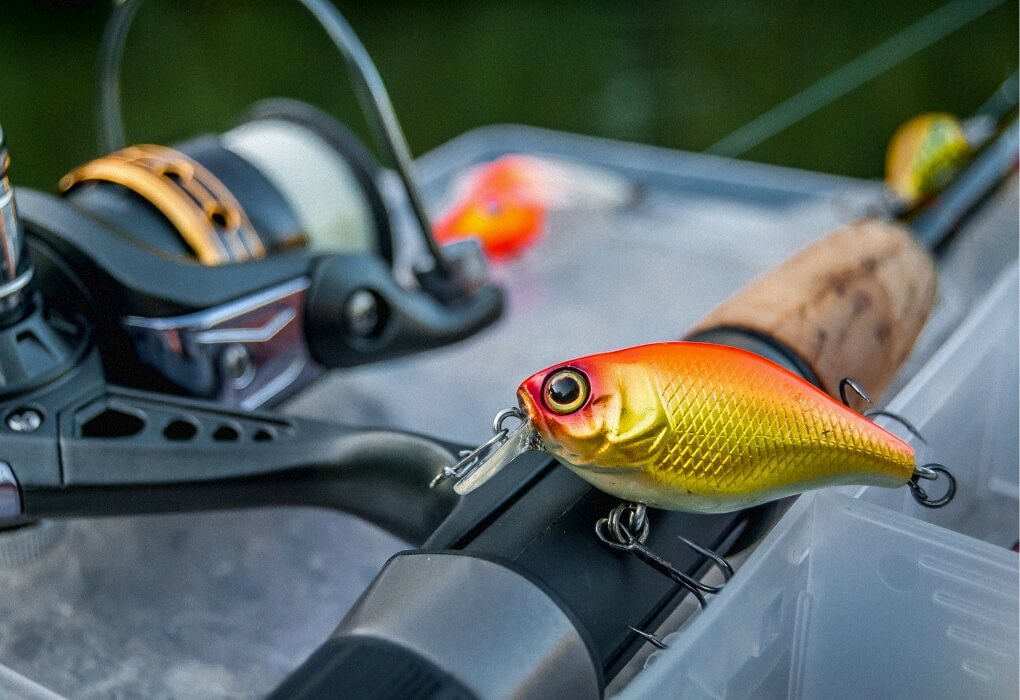
The Uni Knots, and the Improved Clinch Knots are arguably the best knots for fishing lures.
As a newbie angler, you’ll have less trouble with these knots as they’re relatively easy to learn and tie.
However, the Palomar Knot might be the best choice if you have a braided line.
Understand Different Types of Fishing Lines Used With Knots
Knowing the basic types of fishing lines will enable you to pick the right bass fishing knot.
These varieties of fishing lines include:
- Braided fishing lines
- Fluorocarbon fishing lines
- Monofilament fishing lines
Final Cast
Using the best bass fishing knots for the line and lure you’re using will help you avoid breaking off that lunker of a lifetime.
You’ll increase the fun and decrease the heartache when bass fishing.
We hope you’ve learned everything you need to know about the best fishing knots for bass, be sure to let us know what your favorite knot is in the comments below!




